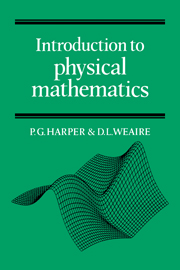Book contents
- Frontmatter
- Contents
- Preface
- Some notes on notation
- 1 Introduction
- 2 Errors
- 3 Cartesian coordinates
- 4 Vectors
- 5 The scalar product
- 6 The vector product and rotation
- 7 Matrices in physics
- 8 The transformation of matrices
- 9 The matrix eigenvalue equation
- 10 Exponential and logarithm functions
- 11 Sine and cosine functions
- 12 Graph plotting and curve sketching
- 13 Differentiation
- 14 Approximations
- 15 Power series and Taylor's expansion
- 16 Partial differentiation
- 17 Integration
- 18 The differential equation
- 19 Solving first-order differential equations
- 20 Second-order differential equations
- 21 Solving second-order differential equations
- 22 The complex exponential
- 23 The circuit equation
- 24 Harmonics and Fourier series
- 25 The diffusion equation
- 26 Waves
- 27 The rate of change of a vector
- 28 The scalar field and gradient operator
- 29 The vector field
- 30 Line integration
- 31 The potential field
- 32 Surface and volume integration
- 33 Flux and divergence
- 34 Circulation and the curl
- 35 Conclusion
- 36 Miscellaneous exercises
- Index
35 - Conclusion
Published online by Cambridge University Press: 20 October 2009
- Frontmatter
- Contents
- Preface
- Some notes on notation
- 1 Introduction
- 2 Errors
- 3 Cartesian coordinates
- 4 Vectors
- 5 The scalar product
- 6 The vector product and rotation
- 7 Matrices in physics
- 8 The transformation of matrices
- 9 The matrix eigenvalue equation
- 10 Exponential and logarithm functions
- 11 Sine and cosine functions
- 12 Graph plotting and curve sketching
- 13 Differentiation
- 14 Approximations
- 15 Power series and Taylor's expansion
- 16 Partial differentiation
- 17 Integration
- 18 The differential equation
- 19 Solving first-order differential equations
- 20 Second-order differential equations
- 21 Solving second-order differential equations
- 22 The complex exponential
- 23 The circuit equation
- 24 Harmonics and Fourier series
- 25 The diffusion equation
- 26 Waves
- 27 The rate of change of a vector
- 28 The scalar field and gradient operator
- 29 The vector field
- 30 Line integration
- 31 The potential field
- 32 Surface and volume integration
- 33 Flux and divergence
- 34 Circulation and the curl
- 35 Conclusion
- 36 Miscellaneous exercises
- Index
Summary
For the last hundred years, much of the theory of physical science has been concerned with the analysis of solutions of partial differential equations – the Laplace Equation, the Poisson Equation, Maxwell's Equations, the Wave Equation, the Diffusion Equation, Schrödinger's Equation.…
We have touched upon some of these but have stopped at the very brink of a wider discussion of them, in their three-dimensional forms. We can already see or anticipate some of the lines of attack which might be used when the solution of a partial differential equation is not obvious.
First, the solution may be represented as a sum over some convenient set of functions and an attempt made to find the coefficients. This reduces the problem to one of matrix algebra, which is often a great relief. A further simplification of the problem is achieved if an awkward term can be discarded from the equation and the solution obtained without it. The missing term can then be put back in an approximate way by use of perturbation theory, a technique which is used everywhere in quantum mechanics but has its antecedents in early work on the dynamics of planetary orbits. Such methods have been given an elegant formal basis in the modern theory of linear operators.
Finally, the solution function may be represented by values on a discrete grid of points, whereupon the differential equation becomes a difference equation and we are once more in the realm of matrix algebra.
- Type
- Chapter
- Information
- Introduction to Physical Mathematics , pp. 243 - 247Publisher: Cambridge University PressPrint publication year: 1985



